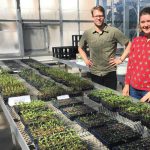BioCycle June 2015
SITES Rating System Acquired By GBCI
In an exciting development, Green Business Certification Inc. (GBCI) acquired the SITES rating system, the most comprehensive program and toolkit for developing sustainable landscapes. SITES was developed through a collaborative, interdisciplinary effort of the Lady Bird Johnson Wildflower Center at The University of Texas at Austin, the American Society of Landscape Architects (ASLA), and the United States Botanic Garden. The rating system can be applied to development projects located on any landscape with or without a building. The Wildflower Center and ASLA will help GBCI create and implement SITES credentialing and certification offerings, and will provide training for projects interested in applying SITES at corporate campuses, streetscapes, homes, and other landscapes.
“Landscapes knit together the fabric of our communities,” said Rick Fedrizzi, CEO of GBCI. “And sustainable landscapes are critical in their ability to reduce water demand, filter and reduce storm water runoff, provide wildlife habitat, reduce energy consumption, improve air quality, improve human health, and increase outdoor recreation opportunities. SITES is an important addition to our toolkit, and GBCI appreciates this opportunity to support this additional contribution to healthy, thriving communities and neighborhoods.”
GBCI is a nonprofit organization that provides third party certification and credentialing services for the widely used LEED (Leadership in Energy and Environmental Design) standard and several other standards. The SITES rating system uses progressive industry standards for landscape design and incorporates additional recommendations from technical experts in the fields of soil science, botany and horticulture, hydrology, materials, and human health and well-being. Some of the credits for sustainable landscape performance have been developed in alignment with similar credits in the U.S. Green Building Council’s LEED rating system, the world’s most widely used green building program.
SITES, originally modeled after LEED, was under development for seven years at the Wildflower Center under the guidance of the original program collaborators. It draws on the experience gained from a two-year pilot program involving more than 100 projects. Forty-six of these pilot projects have achieved certification, including landscape projects at corporate headquarters, national and city parks, academic campuses and private homes. Interested project teams can visit www.sustainablesites.org for more information and to register their projects and access the SITES v2: Rating System For Sustainable Land Design and Development, a guide that provides best practices, performance benchmarks and tools for creating ecologically resilient landscapes, and rewards successful projects through certification.
Global Food Security
In May, U.S. Department of Agriculture Secretary Tom Vilsack addressed the G-20 Agriculture Ministers in Istanbul, Turkey, after endorsing the final communiqué on food security developed by the group. Vilsack began his address by highlighting how important it is for member countries of the G-20, which represent about 85 percent of global gross domestic product and over 75 percent of world trade, to “come together to develop strategies for achieving sustainable food systems and to recognize how reducing food loss and waste is critical to our overall food security around the world.” Vilsack recognized that “most important from the U.S. perspective is acknowledging the importance of reducing post harvest loss and food waste and the positive effect that can have on increasing food security” and noted “the significant extent of food loss and waste throughout the food value chains and the negative consequences for food security, nutrition, use of natural resources and the environment.” Instead of regulating or compelling people to stop wasting food, Vilsack mentioned that the communiqué by the G-20 members “suggests investment at all stages of the food value chains to help raise productivity, generate employment and incomes, and reduce food losses and waste.”
Edible Food Disposal Illegal In France
To curb wasting of food, France’s National Assembly voted unanimously on May 21, 2015 for a new law that makes it illegal for large supermarkets to throw away any food that is considered edible. “To see bleach poured onto edible food in the waste bins at large supermarkets is scandalous,” said Guillaume Garot, a Socialist Party deputy and former agriculture-food minister who authored the law. Under the new rule, as of July 2016, all supermarkets of 4,300 square feet or larger must make every effort to prevent food waste, which can amount to as much as 30 to 40 percent of all food produced worldwide. Unsold edible food waste must either be donated to charity, used for animal feed or for agricultural compost or energy production.
Representatives of French grocers were not overly enthusiastic about the move. Jacques Creyssel, managing director of the Federation of Commerce and Retail, said the law missed the target because large retail establishments represent only 5 percent of food waste and are the “first to donate.” Over 4,500 stores already have donation agreements with charitable groups, he added. Michel-Edouard Leclerc, son of the founder of France’s giant retail chain that bears his name, underlined the need for a plan to help associations get equipped with refrigerators and trucks in order to facilitate food donations. “It’s fine to forbid waste, but the collection must be organized on the other end,” he said.
It is estimated that per person, France discards between 45 and 65 lbs/year of food, worth between $13.5 and $22.5 billion. The French Government has fixed a target of cutting wasted food in half by 2025.
California Assembly Ban On Plastic Microbeads
The California Assembly passed AB 888 in May, a bill that bans plastic microbeads in personal care products sold in California. AB 888, authored by Assembly Member Richard Bloom (D-Santa Monica), received support from over 40 water agencies and environmental and health advocacy organizations in California, including Californians Against Waste, the California Association of Sanitation Agencies, and the 5 Gyres Institute. Plastic microbeads are tiny plastic pieces, measuring less than 5 millimeters in diameter, that are added to facial scrubs and other personal care products as exfoliants or colorants. Once plastic microbeads enter the sewer system, toxins can adhere to them. In turn, they can be mistaken for food by fish and other aquatic animals. It is estimated that 471 million plastic microbeads are released into the San Francisco Bay every day.
Natural alternatives to the plastic microbeads include apricot shells and cocoa beans. The California Senate and Governor Jerry Brown must approve AB 888 before the legislation becomes a law. If passed, it will go into effect January 1, 2020.
Model Packaging Legislation
UPSTREAM, a U.S.-based organization focused on adoption of product-oriented environmental policies, released model legislation that state legislatures can adopt to “optimize recycling, address litter and grow green jobs through shared responsibility for packaging.” The model legislation was developed by UPSTREAM in consultation with local government officials and recycling experts throughout the country. “Everyone wants to boost recycling and prevent litter,” explained Matt Prindiville, Associate Director for UPSTREAM. “The good news is that we know how to do it. There are a suite of policy tools and operational tactics that have been proven to solve both problems. The bad news is that many of these ideas cost money, and that money has to come from somewhere. It’s fair for some of that funding to come from the companies who put the packaging out there in the first place.”
Titled “Shared Responsibility for Packaging,” the model legislation would create a Sustainable Packaging Trust to receive funds from producers of packaging to be used toward achieving a recycling rate of 75 percent by weight for all household packaging.
The Trust will be administered by a newly-created Sustainable Packaging Authority, which will be governed by a board of directors whose membership will include: Producers of products or product packaging, city and county solid waste agencies, recycling and solid waste collection companies, manufacturers and end-users receiving recyclable materials, and statewide environmental organizations. The Authority would be “charged with reducing the amount of postconsumer packaging that ends up as waste” by improving the efficacy and infrastructure for collection, reuse and recycling of discarded postconsumer packaging, compensating municipalities for the costs of collecting and handling, and encouraging reduction of packaging for consumer goods and increasing recycled content.
“The model legislation is an evolution in thought concerning extended producer responsibility (EPR) and packaging,” adds Prindiville. “After years of attempting to replicate European systems, we realized we needed to develop a uniquely American model to address the different challenges and opportunities present in the U.S.











